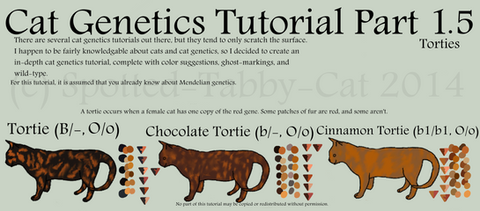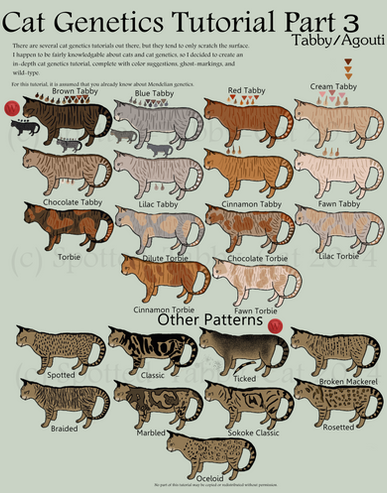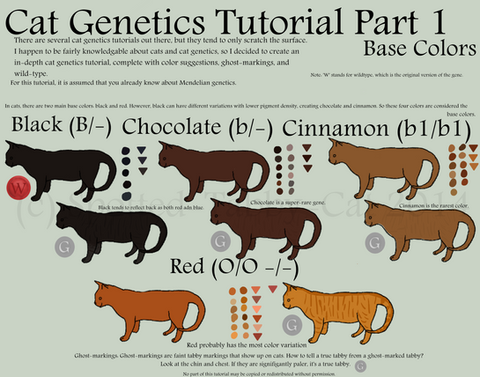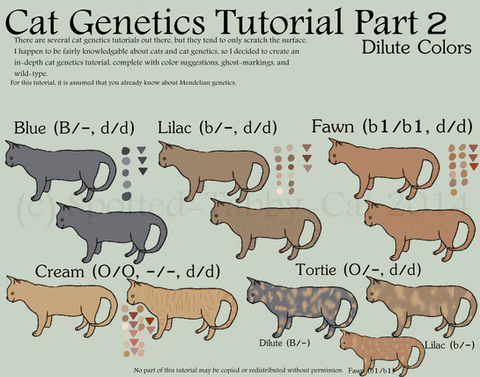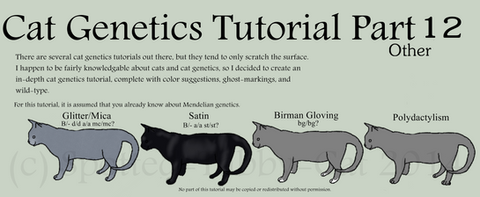HOME | DD
 Spotted-Tabby-Cat — Cat Genetics Tutorial Part 4 (White)
Spotted-Tabby-Cat — Cat Genetics Tutorial Part 4 (White)

#catgeneticstutorial
Published: 2014-12-23 00:37:24 +0000 UTC; Views: 42519; Favourites: 317; Downloads: 194
Redirect to original
Description
This tutorial is out of date. Please see more information here .
There are multiple cat genetics tutorials about, but they tend to only cover the basics (base colors, dilutions, tabby, white-spotting, pointism, & tortie/orange). In-depth cat genetics tutorials tend to be lacking. So thus, this. I have no idea how long this will take to be completed. Hopefully before 2016.
NOTE: THERE IS A MISTAKE!
There should be no wild type at all on this part. I accidentally added wild type to Grade one and roan/tweed. This will be fixed as soon as possible
Part four is finally here. White-spotting and other white markings are up next. White-spotting is a very common trait, so a randomly chosen moggy probably has white-spotting. White-spotting is split up into ten grades with increasing amounts of white. Dominant white is a dominant gene, but happens to be rather rare. A dominant white cat is born with a patch of color on top of it's head, and this patch usually fades away before the cat is a year old. Next up are weird and unusual mutations. Quite honestly, no one knows what causes any of these mutations. Sheeted cats occasionally have a much thinner stripe which is called belted. Normally the European mutation has less white speckling, with the white speckling more towards the white points. Sometimes there are no white speckles at all, just the white points. Roan/tweed is unusual, and just adds white hairs intermingled with colored hairs. The amount of white hairs to colored hairs varies, but it tends to lean toward more colored hairs. The Finnish mutation is a mutation that comes from an inbred colony of cats in Finland. This mutation is associated with infertility, and it is unknown whether the mutation causes the pure white markings, or if that comes from white-spotting. The Moscow mutation is a snow leopard-esque mutation originating in Russia. Notice the silver hint to the coat except for the white muzzle. Since white-spotting normally comes from the bottom to the top of a cat, skunk stripes are unusual. Notice the 'frame' of white. Brindled is pretty much a tortie with white instead of red or cream. This could be a somatic mutation or a genetic mutation. Swirled markings are asymmetrical, and it could be a mutation or an unusual expression of white-spotting. The skunk stripe could be that too. And onto the last one: unusual spots. These are strange spots of color in white-spotting. Colored muzzle/chin spots are rather common, but speckles on paws, patches on toes, and reverse lockets not so much. Nose colors tend to turn pink or have pink patches.
Here are some good white-spotting terms worth noting:
Locket - Small patch of white on chest (Grade 2)
Button - Small spots of white on belly (Grade 2)
Tuxedo - Black with white paws, belly, chest, and muzzle, white tail tip possible (Grades 3-4)
Mask & Mantle - White with colored head, and back & tail (Grade 6)
Harlequin - White with random white patches (Grades 7-8)
Piebald - 50% white or more (Grades 5-9)
Mitted - White paws, other white markings possible (Grades 2-4)
Van pattern - White with colored tail and head spots (Grades 8-9)
Moorish-Headed - White with colored tail and head (very rare, Grade 9)
Part 1 (Base Colors):
Cat Genetics Tutorial Part 1 (Base Colors)
Part 1.5 (Torties):
Cat Genetics Tutorial Part 1.5 (Torties)
Part 2 (Dilutions):
Cat Genetics Tutorial Part 2 (Dilutions)
Part 3 (Tabby):
Cat Genetics Tutorial Part 3 (Tabby/Agouti)
Part 4 (White-Spotting):
Cat Genetics Tutorial Part 4 (White)
Part 5 (Pointism & Albinism):
Cat Genetics Tutorial Part 5 (Pointism & Albinism)
Part 6 (Silver & Gold Series):
Cat Genetics Tutorial Part 6 (Silver & Gold Series)
Part 7 (Color Changes):
Cat Genetics Tutorial Part 7 (Color Changes)
Part 8 (Weirdos):
Cat Genetics Tutorial Part 8 (Weirdos)
Part 9 (Hair):
Cat Genetics Tutorial Part 9 (Hair)
Part 10 (Tail):
Cat Genetics Tutorial Part 10 (Tail)
Part 11 (Ears):
Cat Genetics Tutorial Part 11 (Ears)
Part 12 (Other):
Cat Genetics Tutorial Part 12 (Other)
Related content
Comments: 48

👍: 0 ⏩: 0

👍: 0 ⏩: 0

👍: 0 ⏩: 0

thank you for making this!
this helps me alot! <333
👍: 0 ⏩: 1

You're very welcome, and thanks for your kind words!
👍: 0 ⏩: 0

Does the S/s gene need the W gene there to be active, or is it a separate thing on its own? As in, what activates the S/s gene? Is a cat with no white spotting ww ss or just ss or what? I know that Ss creates differing amounts of spotting right? But all the places I've looked also say that ss creates small amounts of spotting. So what makes a cat have no white at all?
👍: 0 ⏩: 1

The white-spotting and dominant white genes are separate, so any cat with S will show white-spotting, regardless of the presence or absence of W (although this article seems to suggest that they are on the same locus). A cat with no white-spotting would (probably, since genetics can be weird and mutations can happen, such as the ones in the 'odd' section above, and sometimes stuff just happens and you might get a few white hairs) be ww/ss, correct. As for the incomplete dominance of S, we don't really know. It's theorized as such, but no real studies have been done to my knowledge. Personally, I'm a rather big believer and polygenes, and given the fuzzy line between 'maximal heterozygous expression' and 'minimal homozygous expression', I'd be inclined to theorize that it's just a simple off/on gene with polygenes and random chance controlling the expression.
👍: 0 ⏩: 0

you seem to be very educated about cats! if you have time, could you explain this cat's coloration? my mother's friend saw this guy and i've simply never seen a cat like this!
👍: 0 ⏩: 1

This looks most similar to the above listed European Mutation (which has since been named Karpati), which can also present itself without the roan/tweed main body. Does your mom's friend live anywhere near the Carpathian mountains, since that is around where the mutation seems to have originated?
👍: 0 ⏩: 1

yes!!!!!!!!!!!!!!!!!!!!!!!!!!!!!!!!!!!!!!!!!! you truly are a cat expert o my gosh!
👍: 0 ⏩: 0

Can a cat be brindled and a tortie/torbie? Or is one dominant over the other?
👍: 0 ⏩: 1

Brindling is a mutation of a tortie pattern where for whatever reason no red pigment is produced, leaving just white spots. Technically, any brindled cat is a tortie, but you won't be seeing any red on them.
👍: 0 ⏩: 1

That makes sense, thank you!
👍: 0 ⏩: 1

Glad I could help!
👍: 0 ⏩: 0

I usually refer to my cat as a ''grey tux' but it's kinda complicated. He's grey with dark grey tabby stripes the stripes are barely noticeable, but the rings around his tail are very pronounced. I'd say he's a grade 6, (not a true tuxedo), but his patches are more broken up. as he has grey spots on the back on all four feet.
What should i refer to him as?
Tabby and white?
Grey tux?
👍: 0 ⏩: 1

He might be a solid blue (grey) with rather pronounced ghost markings or an actual tabby, it's kind of hard to tell without pictures. Often the belly and muzzle would be lighter in a true tabby, but it sounds like all that is covered by white, so it might come down to mostly guesswork. Assuming he's solid (if not, just add tabby), the technical name would be blue and white, although you could say grey with white since most people will better understand that. I probably wouldn't call him a tuxedo since tuxedo is a very distinct pattern and it doesn't sound like he matches this exact pattern, although it doesn't really hurt if you do call him as such.
👍: 0 ⏩: 0

The color pattern (Or hat as my family called them) doesn't always disappear when they grow older (does it?). I've had two cats with the Hat where it never disappeared. . . all do they both only lived to be around 7.
👍: 0 ⏩: 1

It depends on what causes the hat. If it is caused by white-spotting, it will not disappear, but if it is caused by dominant white it will.
👍: 0 ⏩: 1

Ah, that makes sense. Thank you for clarifying.
👍: 0 ⏩: 1

May I ask, if a cat has a Roan/Tweed patten can they still get white markings? My kitten is a blackish gray cat who looks like a smokey tabby only with some individual white hairs and grade 2 white spotting, I've been very confused on her unique pelt.
👍: 0 ⏩: 1

Yep! They are caused by two separate genes, so they should be able to appear together. It is possible that the genes are related and influence each other, but I haven't come across anything suggesting so.
👍: 0 ⏩: 0

Could I ask you a question? Can cats get random birthmarks? Like, a singular black spot on their foot?
Cause I have a orange/white male that has a black fur spot on one of his back legs and no where else
👍: 0 ⏩: 1

Yep! They often are little dots normally seen around the mouth, nose, and eyes like freckles, but can be larger and in other places.
👍: 0 ⏩: 0

Both of my cats have white spotting. My male is somewhere between a grade 5 and grade 6, whereas my female is a 6. They both have a few odd markings on them, however. My male has a patch of color on the back of his right hind leg and one on his front left paw, his jaw and part of his throat are colored, and he has a white patch/line running from his shoulders to the base of his tail. On my female, almost the entire back of her left hind leg is colored. Would these just fall under unusual spots, or would the white stripe on my male count as a skunk stripe?
Edit- Oh, and they both have quite a few stray white hairs among the colored hairs, as well.
👍: 0 ⏩: 1

White-spotting is very common, very cat I've had had it to some degree or another. The white spot on the male sounds pretty much like a skunk stripe. Do you have any pictures? Then again, these categories aren't very strict, more generalizations to help describe markings. Stray white hairs happen too. One of my cats was almost van, just a few stray spots down her back and she had white hairs all over her tail.
👍: 0 ⏩: 1

Yeah, I have a few pictures of him showing the white patch: i.imgur.com/WrrT4CA.jpg i.imgur.com/21oFehc.jpg i.imgur.com/wAaU5Z1.jpg
👍: 0 ⏩: 1

It seems much patchier than a skunk stripe. Maybe a partial skunk stripe?
👍: 0 ⏩: 1

Hm, perhaps. Could it also be possible that it's just random white patches, though?
👍: 0 ⏩: 1

Yep. As far as I know there is no skunk stripe gene, it's just a way to describe unusual patches of whits.
👍: 0 ⏩: 0

My cat is somewhere between Grade 6 and Grade 7. :3
👍: 0 ⏩: 1

It isn't uncommon for cats to fall in-between white-spotting grades.
👍: 0 ⏩: 1

But then his dark grey tail has black rings on it. Weird Cat. XD
👍: 0 ⏩: 0

Hello. I had a question where my cat would fall under since she is almost 100% black with slight rusting underneath even all four pads, nose, and eyes are black.. Yet she has ONE single white hair on her shoulder and a white patch under her belly between her back two legs. Everywhere else she looks like a 100% black cat. Her eyes are hazel/gold as well.
👍: 0 ⏩: 1

Your cat is probably solid. In my experience, every spayed/neutered cat has a white patch iinbetween their back legs due to scarring from the surgery, and occasionally white hairs happen from scarring, or a mutation in the cells of the hair. I hope this helped!
👍: 0 ⏩: 0

I've always wondered if the dominant white pattern was genetic. We have a green-eyed white male who only had a black spot on his forehead for the first few months or so.
👍: 0 ⏩: 0

I think that if a cat had two white feet, it would have two white hind feet. Also, if a cat had three white feet, it would have two white hind feet and either a left front foot or a right front foot that is white. Cats that have four white feet often have more white on the back feet than the front feet. Dogs and rabbits on the other hand most likely have two white front feet if they have two white feet. Dogs with four white feet usually have more white on the front feet than the back feet. There are otherwise all-black (or other color) furred rabbits that have two white front feet as the only white they have on them.
👍: 0 ⏩: 1

I agree with your description on the cats. For the dogs, all I know is that a friend's dog has equal white (more or less) on all four feet. On the rabbits, I defer to you.
👍: 0 ⏩: 1

For an example, here is a link to a picture of a cat with two white hind mitts, a white bib, and no front mitts.
www.pegnsean.net/~railwayserie…
👍: 0 ⏩: 0

My cat just had kittens with unusual white spots. One is a grade 3-4 it has one white foot saddle across chest that wraps around neck like a broken collar, and a single white circle mid back, otherwise it is a ginger spotted tabby.
Cat two is pure orange spotted, with a white face
third is white face, 3 white feet, white chest, and two bright white bands around back legs.
👍: 0 ⏩: 2

Strange things can happen with white-spotting, although, I don't think I've ever seen a cat with white bands around the back legs. On the third kitten, was the non-white foot on the front or back?
👍: 0 ⏩: 0

Did the cat with a white face only have the white face look like Ortensia (Oswald The Lucky Rabbit, Epic Mickey) the Cat's white face.
👍: 0 ⏩: 0

I heard that there are a few ways a cat can get white fur or white markings on its fur:
1) white spotting; from no expression of the gene to looking completely white (S gene)
2) white gloving; with white only on the feet found in Birmans (G gene)
3) particolor spotting; often looks like a mask-and-mantle with an upside down "v" shaped facial blaze (hypothetical Sp gene)
4) van patterning (hypothetical Wv gene)
5) white mitting; white on feet in Snowshoes and Ragdolls (hypothetical Sb gene)
6) white locketing; white lockets, tail tips, chin spot or chin, toe spots or toes, and buttons or brisket spotting (small white spots on the belly and groin)
7) a few white hairs on an otherwise completely colored coat; can be the most minimal form of white locketing or white spotting
8) dominant white (W gene)
👍: 0 ⏩: 1

I have heard about those hypothetical variations on the white-spotting gene, but I haven't really seen any proof of them - they are merely ideas that maybe this separate gene causes this variation that we have a name for. I personally think that it is much more likely that polygenes have the largest amount of control on how much white (and where) a cat has.
As for the Birman gloving gene, it might exist. I'm not sure as to what research has been done into determining if it is a unique gene or just an expression of the white-spotting gene. I'll do a bit of research on that.
To my knowledge, the small white spots would be caused by simply minimal expressing of the white-spotting gene.
👍: 0 ⏩: 0

Here are a few other white spotting inaccuracies and rarities:
1) A low-grade white spotted (like mitted, Birman gloved, and tuxedo), locketed, or otherwise non-white-spotting-patterned cat with a completely white head or an all-white head apart from the ears or small head splotches. (Inaccurate) Completely white heads happen only on all-white cats and extreme white spotting patterned cats (Grade 9) and mostly white heads are on higher grade bicolor patterned cats or higher (like harlequin or van).
2) A low-grade white spotted (like mitted, Birman gloved, and tuxedo), locketed, or otherwise non-white-spotting-patterned cat with all white ears or any white on the ears, including white ear tips. (Inaccurate) A cat has to be at least a mid grade level of white spotting to have any white on the ears.
3) A locketed or otherwise non-white-spotting-patterned cat with a white tail tip. (Very to extremely rare) Cats with white tail tips almost always have at least a mitted pattern.
In cartoons in the 1920s and 1930s, there are a lot of cat characters that are all black apart from their white muzzles (like Felix the Cat) or facial "masks" (like Ortensia, Oswald the Lucky Rabbit's girlfriend) The only real cat that appears black with a white muzzle and without mitted feet that I've heard of is Oreo, a kitten on the Animal Planet show, Too Cute.
How common, uncommon, or rare is it for a real cat that is locketed, mitted only, or otherwise non-white-spotting-patterned to have a white muzzle or facial "mask"?
How common, uncommon, or rare is it for a real tuxedo cat to have a white facial "mask" (like the cartoon cat Figaro from Disney's Pinocchio)?
👍: 0 ⏩: 1

Very true on ll accounts.
To answer your questions, I think that it'd e fairly rare for a colored cat to only show white on the face. I have never seen one, and a cursory glance on Google didn't turn up anything. It seems to be possible. Maybe it could an unusual locket that is higher up than normal and extends onto the face? Or perhaps the main locket part is covered up by one of those weird random colored splotches in white?
As for a tuxedo to have a white face, it is possible, but probably rather uncommon.
Slightly unrelated to your post, but relevant, I think, are 'Moorish-Headed' Cats. They were said to be white with a black head and tail. To my knowledge there are no known photographs, but there are drawings.
👍: 0 ⏩: 1

Here is an article by Welcome to Chiangmai and Chiangrai detailing various historical Thai cat breeds and varieties.
We Are Siamese if You Please... article by Welcome to Chiangmai and Chiangrai: www.chiangmai-chiangrai.com/si…
Messybeast also has an article on historical Thai cat breeds and varieties.
Some of the varieties and breeds look like various types of white spotting patterns.
1) Gao Taem: a high-grade white-spotted cat with nine black spots, with black toes and a spot on the head, neck, both shoulders, back, rump, and thigh. Appears to be a variant of a harlequin pattern, but with a white instead of black tail.
2) Grob-Wen (An-Maar): a high-grade white-spotted cat with a black saddle and black eye patch markings on both eyes. Appears to be a variant of the cap-and-saddle pattern, but with a white instead of black tail.
3) Kra-Jork: a black cat with a white muzzle and copper eyes.
4) But-Se-Weis (But-Ta-Lon): a black cat with a white dorsal stripe from nose to tail tip. Appears to be an otherwise all-black cat with the skunk stripe marking, except it's the "nose to tail tip" type than the usual "restricted to the back" type.
5) Ni La Chak: a black cat with a white collar marking on its neck.
6) Singh Hasep: a black cat with a white collar marking on its neck, a white muzzle, and orange eyes.
7) Mulilaa: A black cat with all-white ears.
8) Ja-To-Bot: A black cat with yellow eyes and white feet or legs on all four feet or legs. Looks like a variant of the mitted pattern or the mitted-only/gloved pattern.
9) Wilart: A black cat with a white dorsal stripe from the top of the head to the tail tip, white from chin to chest, and white feet. Appears to be a mitted or tuxedo cat with a "head to tail tip" variant of the skunk stripe marking.
10) Garn Waek: A black cat with a white nose bridge.
How possible or common are each of these patterns in real life cats?
👍: 0 ⏩: 0

Here are some other cat white spotting patterns:
1)Cap-and-saddle cat: looks white with color on head, tail, and saddle-like patch on the back (Grade 7)
2)Mitted only or gloved cat: white only on the feet, signature markings on the Birman (Grade 3)
3)Extreme white piebald cat: looks white with small splashes of color on the body and head; unlike other white spotting patterns, extreme white or Grade 9 patterns do not have to have a fully colored tail (Grade 9)
4)High-mitted cat: one of the white spotting patterns on the Ragdoll, it looks a lot like the bicolor Ragdoll, but is a more extensive version of mitted (Grade 5)
5)Tail-only cat: looks white with color only on the tail (Grade 9)
👍: 0 ⏩: 0
